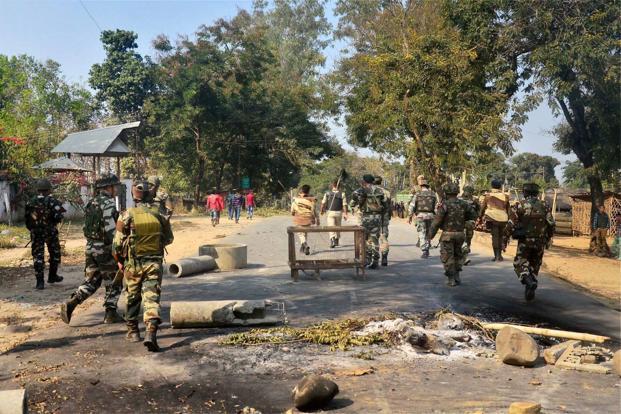
As it stands, Naga homelands in Manipur are with Manipur only on paper.
It was interesting to read a report in The Indian Express earlier this week which suggested a Naga peace deal was at hand, but assembly elections over 4 and 8 March in Manipur, which has large Naga homelands, had slowed the process. The report also suggested that a degree of autonomy in Naga homelands would be part of the deal that hopes to please all sides, including the majority Meitei people of Manipur, who are terribly sensitive about territorial integrity.
I’ve been telling you so for several months; that nothing would move till results arrive—on 11 March—because the Bharatiya Janata Party (BJP) wants to electorally wrest Manipur from the Congress and its three-term, and incumbent chief minister, Okram Ibobi Singh, who has projected himself as saviour of the Meitei even as he presided over the desolation of Manipur. This has led to the conflation of politics and peacemaking.
Let me offer some perspective.
Four days after the government of India signed a so-called framework agreement for peace with National Socialist Council of Nagalim (Isak-Muivah), or NSCN (I-M), the largest Naga rebel group, in the column Balancing the Naga accord (7 August 2015) I mapped contours of some solutions to one of South Asia’s knottiest problems.
One aspect was of course mainstreaming rebels by absorbing some cadres into policing functions, or paramilitary functions such as an industrial security force, in the manner, say, that Nepal achieved with its former Maoist rebels.
The trickier aspect would be to integrate rebel leadership into the mainstream as there is a matter of saving face as well as the necessity of making peace worthwhile for fat cats—rebel and non-rebel alike.
For the Nagas this is a matter of some rigour. The Nagas comprise 16 major and numerous minor tribes—NSCN (I-M) is perceived as largely Tangkhul-led and Tangkhul-peopled, a tribe with its homeland in Manipur. Thuingaleng Muivah, the M in I-M and signatory to the “framework agreement”—is Tangkhul. So is Phungthing Shimrang, its army chief; as are several other leaders and numerous cadres. This makes it problematic for I-M in post-peace Nagaland, which has its own specific tribal homelands and entrenched political and economic patronage.
Besides, such integration, as I have earlier written, would require a Lalthanhawla-like figure. The Congress chief minister of Mizoram stepped aside in 1986 for Mizo rebel leader Laldenga and the cause of peace. We saw how it works over 19-22 February. Nagaland’s chief minister T.R. Zeliang was compelled to resign after massive public unrest over urban-body elections. He made way for Shürhozelie Liezietsu—but Zeliang retained control over the all-important finance portfolio: as finance advisor with cabinet rank. They also temporarily thwarted another contender, arch-foe and former chief minister Neiphiu Rio.
Tangkhul rebel leadership and cadre are impelled to consolidate their hold in Manipur. This will be true even if I-M general secretary Muivah is offered a ceremonial role of an elder statesman among the Nagas, who also have contiguous homelands in Assam and Arunachal Pradesh. Whatever Muivah’s future role, his ambitious subordinates will require appeasing. The United Naga Council (UNC), the apex body of Naga tribes in Manipur, seen by many as an I-M proxy, has over the past three years escalated its demand for what it calls “Alternative Arrangement”—autonomy by another name. UNC alleges that Manipur’s government, weighted by the Meitei, has discriminated against the non-Meitei. UNC wants administrative autonomy in Manipur’s Naga homelands.
“A settlement with NSCN (I-M) cannot come about without adjustments in its pocket borough,” I wrote. “There’s been talk of giving the alternative arrangement wing with control over finance, administration and development, but to allow the government of Manipur to retain control over police functions.” The precise formula is a matter of ongoing negotiations.
This will need to be balanced with calming sops to the Meitei and non-Naga tribal folk in Manipur—the Kuki-Chin people—and rebel groups who claim to speak for them. They have for long seen NSCN (I-M) as aggressors, instigators of territorial bloodletting.
As it stands, Naga homelands in Manipur are with Manipur only on paper. “While that paper territoriality is crucial to maintain equilibrium,” I wrote in 2015, “actual ceding of administrative control would require balancing with massive development input in Manipur, and emotional sops such as scaling back the Armed Forces (Special Powers) Act, 1958, and acquiescing to an Inner Line Permit system that protects the rights and livelihoods of particularly the non-tribal, plains-residing Manipuri …”
We’ll know soon enough.
Sudeep Chakravarti’s books include Clear.Hold.Build: Hard Lessons of Business and Human Rights in India, Red Sun: Travels in Naxalite Country and Highway 39: Journeys through a Fractured Land. This column, which focuses on conflict situations and the convergence of businesses and human rights, runs on Thursdays.
Source: Livemint



